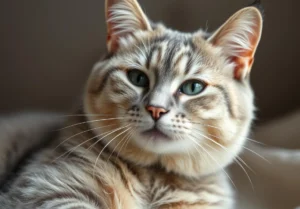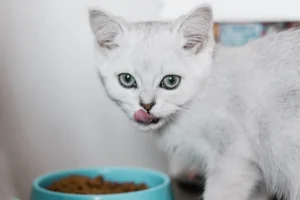Disclosure: We may earn a commission from helpful, relevant links in our content. No cost to you. See our privacy policy.
Cats deserve the gourmet treatment, too.
And when it comes to wet cat food, there’s a variety of options awaiting your discerning judgment.
The choices may seem overwhelming, but our handy guide will help you become a connoisseur of feline cuisine in no time. Stick with us, and you’ll be serving up the perfect plate for your purring pal.
Ready to turn those puzzled looks into purposeful picks? Let’s dive right in.

Is There a Difference in Wet Cat Food Options?
Absolutely! Not all wet cat foods are created equal.
Think of it like dining out: two restaurants might serve spaghetti, but the taste, ingredients, and nutrition can be worlds apart.
The differences in wet cat food range from the quality of ingredients and protein sources to the manufacturing processes and additives. Your cat’s age, health condition, and personal preferences also play a pivotal role.
So, while Fluffy might relish a salmon pâté today, she might need something with kidney support as she grows older. The takeaway? Stay informed and be adaptable, just like our feline friends.
What Makes Wet Cat Food Good?
The hallmark of quality wet cat food is its wholesome ingredients.
Here’s the scoop: the closer the food is to its natural state, the better. Good wet food often boasts a high protein content from real meat sources – think chicken, turkey, or fish rather than ambiguous terms like “meat derivatives” or “animal by-products”.
Moisture is another crucial factor. Cats naturally derive a significant portion of their water intake from food, so a wet food rich in moisture not only satisfies their palate but also supports optimal hydration.
Lastly, consider the additives. The fewer, the better. A touch of essential vitamins and minerals is great, but steer clear of foods drowning in artificial flavors, colors, or preservatives.
In essence, simplicity, authenticity, and nutrition are the trio that makes wet cat food stand out in the best way.
Main Types of Wet Cat Food
Here, you’ll discover the variety and benefits of wet cat food options, ensuring your cat gets the best in taste and nutrition. We’ll also recommend a product we think is great, and we’ll offer some insightful tips for each one.
Pâtés and Loaves
Ever noticed those smooth, spreadable types of cat food that have a consistent texture? That’s pâté. A favorite among many cats, pâtés are usually grain-free and have a high moisture content. Their smooth texture often means fewer additives and fillers.
When shopping for pâtés, prioritize those with a clear indication of the main protein source, like “chicken” or “tuna”, and avoid those with vague descriptions.
One product that fits these requirements is the Wellness CORE Grain-Free Chicken & Turkey Recipe. Crafted from premium chicken and turkey, this pâté offers a protein-rich and grain-free option that’s packed with essential nutrients, without any artificial additives or fillers.
Chunks in Gravy or Jelly
These are the juicy chunks of meat or fish that come swimming in a delightful gravy or jelly. Cats often lap up the gravy with gusto, making it a hit, especially for fussy eaters. This type is also great for hydration.
However, a heads up: sometimes, the gravy might contain thickeners or added sugars. So, peek at the ingredient list and ensure there’s no excess of things you can’t pronounce.
A good example? Royal Canin Intense Beauty in Gravy. Why? Because it’s expertly designed to maintain a cat’s shiny coat and overall health. My cats love it! These juicy chunks not only offer superior taste but are also enriched with omega-3 & 6 fatty acids.
Shredded and Flaked
Imagine tearing apart a perfectly grilled chicken breast. That’s what the shredded and flaked varieties resemble. They offer a more natural, meaty texture which can be particularly appealing for cats who like a bit of bite in their food.
This type can be especially beneficial for older cats who might have dental issues, as the tender shreds are easier to chew.
A great example is Purina Pro Plan PRIME PLUS Adult 7+ Entree. Tailored specifically for senior cats, it provides a balanced blend of chicken and beef in tender shreds, ensuring optimal protein levels and easy digestion.
Morsels in Broth
Light, tasty, and incredibly satisfying – these morsels are often bits of seafood or meat served in a clear broth. They are a top pick for those wanting to ensure their cats get plenty of fluids. This style often boasts a simpler ingredient list, focusing on the purity of flavor and nutrition.
Opt for broths without added salt or artificial enhancers.
We recommend you try out the Tiki Cat Aloha Friends Tuna & Pumpkin in Broth. Made with wild-caught tuna and nutritious pumpkin, it ensures hydration and a rich taste. The broth is pure without added salts, making it an ideal choice for feline hydration.
Gourmet and Specialized Blends
Taking things up a notch, gourmet blends are the fancy feasts of the cat food world. These often combine multiple protein sources and might have additions like pumpkin or sweet potato for added nutritional value. Specialized blends could also cater to specific health needs, such as urinary tract health or weight management.
While they sound (and often are) delicious, always check the nutritional profile to ensure it matches your kitty’s requirements.
A good product: Blue Buffalo Wilderness Wild Delights Flaked Chicken & Turkey. Offering a gourmet blend of flaked chicken and turkey in a savory gravy, it’s grain-free and includes essential vitamins and minerals tailored for cats with specialized dietary needs.
In the ever-evolving landscape of pet nutrition, it’s essential to stay informed and adaptable. What all these varieties offer is a chance to diversify your cat’s diet and keep mealtime exciting. Remember, always transition gradually when introducing a new type of food and keep an eye on any changes in behavior or digestion. Your cat’s purrs and playful demeanor will be the best feedback on your choice!
Related: Popular Cat Food Brands Reviewed
What Ingredients to Look For in Wet Cat Food?
When it comes to what’s inside that can, not all ingredients wear capes. Here’s a guide to the crème de la crème of wet cat food ingredients:
- High-Quality Protein Sources. Your cat is a carnivore at heart. Look for named meats like chicken, beef, salmon, or turkey. These should ideally top the ingredient list, showcasing their dominance in the formula.
- Natural Fats. Don’t shy away from seeing fats in the ingredient list. Healthy fats, such as fish oil or chicken fat, are essential for your cat’s coat shine and brain health.
- Taurine. Cats require this crucial amino acid that they can’t produce themselves. It supports vision, heart function, and more. Always ensure it’s present in the cat food.
- No Fillers, Just Fiber. While you don’t want unnecessary fillers, natural fibers like pumpkin or beet pulp can aid digestion and help with hairball control.
- Vitamins & Minerals. Just like us, cats benefit from a sprinkle of vitamins and minerals in their diet. These should ideally come from natural sources, not synthetic additions.
And here’s a curveball: Beneficial Bacteria. Often overlooked, some top-tier cat foods are now incorporating probiotics into their blends. These good bacteria can boost your feline’s digestive health and enhance immunity. A little unexpected, right? But it could be a game-changer.
Ingredients to Avoid
The flip side of the coin is recognizing the villains in the cat food world. Some ingredients might sound harmless but have no place in your kitty’s bowl. Here’s the lowdown on the no-nos:
- By-products and Meal. Words like “chicken by-product” or “meat meal” can be red flags. They’re often inferior, non-specific protein sources.
- Artificial Preservatives. BHT, BHA, and ethoxyquin? These aren’t the names of extraterrestrial beings but harmful preservatives you’ll want to avoid.
- Excessive Grains and Fillers. Cats aren’t built to digest large amounts of corn, wheat, or soy. These often act as cheap fillers with little nutritional value.
- Added Sugars. Cats don’t have a sweet tooth, biologically speaking. Ingredients like corn syrup or sucrose are unnecessary and can be harmful in the long run.
And for our unique insight: Generic Animal Fats. While animal fats can be nutritious, the term “generic” is a concern. Without specifying the source, these fats can be derived from almost any animal, often the lowest quality ones. Dive deeper into the label, and opt for foods that clearly state the source of their fats, be it chicken, fish, or beef.
Arm yourself with knowledge, and those ingredient lists won’t seem daunting anymore. It’s all about making the best choice for your whiskered companion, and you’ve got the upper hand now.
The Bottom Line: 3 Wet Cat Food Rules
Remember these three rules when choosing wet cat food:
- Pick Protein, Not Puzzles. Always opt for named, high-quality meats over ambiguous terms like “meat meal” or “by-products”.
- Favor the Fresh and Natural. If it reads like a chemistry experiment or includes unrecognizable sugars, it’s a nay.
- Trust Transparency over Trickery. If the label leaves you guessing or seems secretive, it’s not candid cat cuisine.
There you have it – three cardinal rules to be your guiding star on this cat food quest. And remember, each choice you make is a testament to the love and care you have for your feline friend. Your kitty may not grasp the intricacies of ingredient lists, but they’ll surely relish the result of your diligent decisions.
Ready to serve your feline the finest feast? Dive back into this guide whenever you’re in doubt, and trust in your newfound knowledge. With our insights by your side, your kitty’s mealtime will soon be both nutritious and delicious. Here’s to many contented purrs and clean bowls!
Related: Choosing Dry Cat Food Guide
FAQs
Is there a difference in wet cat food?
Wet cat food varies in quality, ingredients, and nutritional value; it’s essential to choose one that aligns with your cat’s dietary needs.
Does the flavor of wet food matter to cats?
While cats have individual preferences, they generally gravitate towards flavors mimicking their natural diet, such as fish or poultry. However, in general, the flavor matters less than the actual food’s nutrition.
Is wet food good for a cat’s dental health?
Wet food provides hydration and nutrition, but doesn’t offer the same teeth-cleaning benefits as dry food’s crunch.
Can I mix wet and dry food for my cat?
Combining wet and dry food can offer both hydration and dental benefits, but ensure the total food intake is nutritionally balanced for your cat.
Alex, a passionate animal lover, has experience in training and understanding animal behavior. As a proud pet parent to two dogs and three cats, he founded AnimalReport.net to share insights from animal experts and expand his knowledge of the animal kingdom.




